Pinehurst: A Farming Town
What Comes and Goes on Oak Avenue
Pinehurst may be tiny (Population: 295), but it holds year-round movement. The crops, the trucks, the crop dusters, the trains—they pass right by my front porch like a procession. I don’t have to chase the world anymore. It comes to me, on tires, wings, and rails.
My house on the edge of town. Beyond those trees out back is open farm fields.
Crops on All Sides
Pinehurst is just one square mile, with Highway 41—also called Pine Street—running down the middle like a spine. On the edges of town, like my street where the houses stop, the farmland begins. Cotton and peanuts are flourishing now. Corn grows nearby, and sunflowers bloom wide and fast before bowing their golden heads.
In June and July it’s watermelon season. That’s when the gray-painted school buses start appearing—windows and seats removed, packed to the brim with melons and carrying them 16 miles south to Cordele, the Watermelon Capital of the World; their hard-earned title celebrated with the Watermelon Festival every year.
I pass one of those tricked-out watermelon-hauling buses on my way through town, and sure enough, another comes from the opposite direction. When they pass each other, the drivers always wave.
There’s something beautiful in that—two watermelon buses in motion, full of fruit, full of purpose, full of summer.
Big Wheels and Small Streets
We don’t have curbs in Pinehurst, so when the tractors and graders roll through town—some with tires as tall as my roof—they sometimes catch the sandy corners of our yards. Two 20-foot graders pass my house on Oak Avenue every day, headed east on Haslam. I know their rhythm now. One appears, then the second one, always close behind. They glide like choreography. Miss Sophia, my cat, and I pause to watch, listen, and feel the vibrations in the floorboards.
The world feeds itself, and I get to watch it happen, one pass at a time.
The Yellow Crop Duster and Mr. Henry’s Crepe Myrtle
Every Wednesday, a bright yellow crop duster flies overhead, spraying for mosquitoes. North-south passes for town. East-west passes for crops. For several days, his arc traced directly over our house—buzzing by so close, I could see the plane clear as a bird.
Mr. Henry next door stopped pruning his crepe myrtle each time the plane roared by. I'd catch both of them in one frame: an 85-year-old man with garden clippers and a buzzing yellow plane above him. Blue skies, white water tower. That’s Pinehurst poetry.
Trains and Tow Trucks, Boats and Four-Wheelers
Two blocks over, the train tracks hum all day and night. Some engineers blare their horns in long crescendos; others give soft, polite taps in the early morning. I can see ‘em roll by north and south from my porch. Summer leaves block some of the view—but I still hear each train announcing and rumbling through town, like constant visitors howling hello.
Meanwhile, my young neighbor across the street works for the power company. He comes and goes in a rotating fleet of trailers, tow trucks, fishing boats, and camo-covered four-wheelers. On Sundays, he trains his hunting dogs in the yard. Sometimes other guys show up in their own rigs, and they all roll out together like a convoy.
The World on My Porch
I used to think I had to travel to see the world. But now I sit on the porch each morning, writing, with a sweet breeze in my lap, cat at my feet, and the world passing by.
Grain haulers. Crop planes. Cotton seed trucks and cotton bail trailers. School buses full of fruit and sometimes children. Trains singing through the trees. Four-wheelers heading to a hunt. The scent of soil, of sweat, of crepe myrtle blooms in the heat. And always birdsong and a frog chorus.
Sometimes I feel like the whole world comes right by my house.
All that motion, all that coming and going — and here I sit, saying so, and saying thanks.
About the Author
Cindi Brown is a Georgia-born writer, porch-sitter, and teller of truths — even the ones her mama once pinched her for saying out loud. She runs Porchlight Press from her 1895 house with creaking floorboards and an open door for stories with soul. When she’s not scribbling about Southern music, small towns, stray cats, places she loves, and the wild gospel that hums in red clay soil, you’ll find her out listening for the next thing worth saying.

